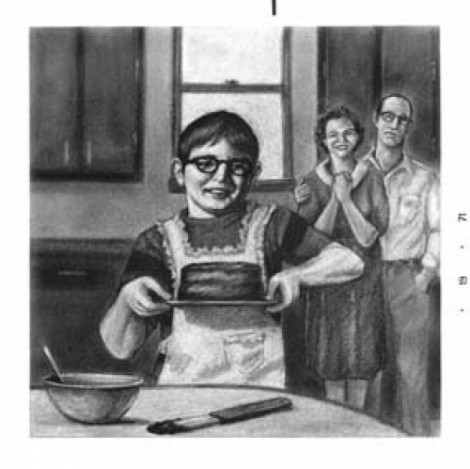
Young grew up in Salt Lake City, and his initial work for his bachelor of fine arts degree at the University of Utah was traditional landscape and figurative paintings. Then, in 2006, he continued his studies at the Vermont College of Fine Arts, where his work took a decidedly different turn. There he felt freer to delve into more psychological and political areas. “Vermont let me really explore what it means to be a queer artist,” he recalls.
nAnd what it meant to be queer, period. “We each have our own stories, and go through our own challenges,” he says. “I grew up in the ’60s and ’70s, and a lot of the same issues are still out there. I’d like to think we’ve made progress, but that’s not necessarily the case.”
nHe took on a different theme during each semester at Vermont. The first semester’s work is gathered under the title Under-eye Cream and Other Findings in My Medicine Chest—a series of self-portraits through grooming products. The “Father/Son” diptych compares shaving cream and other items used by his father with those he himself uses, and will be mounted above a vanity, like an altar, creating religious implications. “It’s about our worship of beauty products,” he explains.
nThe 12 drawings from his second semester are titled One Boy’s Story: Snapshots From My Youth. Intended to look like black and white photographs, they are snapshots of pivotal moments, from feeling awkward in Boy Scouts to his first kiss. “At certain moments you realize there’s something different about you, at first you want to change but can’t,” he says, “and I want that to make people think about their own stories.”
nThe third semester’s work, “Reflections of a Middle-aged Gay Man,” examines our culture’s obsession with youth and beauty. Paintings take traditional figures in art, like “Michelangelo’s David at Fifty” and “The Mid-Life Crisis of Saint Sebastian (after Perugino)” with a humorous tone. This section also includes video interviews with 16 gay men between the ages of 40 and 65, asking them about body image, aging and discrimination. Part of the reason for the exhibit is his own struggle with middle age: “It’s part of my getting it out of my system.”
nThe work from his final semester made up his master’s thesis exhibition in July 2008. “You’re Invited … Discourses on Same-sex Marriage From a Queer Perspective” plunges deeper into video, with interviews of gay and lesbian couples in long-term relationships. There is also a “virtual marriage ceremony” on video, concluded by a list of disclaimers with marital rights not afforded to gays and states where the ceremony wouldn’t be valid.
nYoung started planning the exhibit in spring 2008, before California’s passage of Proposition 8 made the dialogue more urgent. “It’s the first time a whole class of people has been stripped of rights,” he says. “We don’t all necessarily want the religious trappings of marriage, just the civil-rights benefits.”
nHe notes that the Latin root “homo” means “the same,” and hopes it will help viewers celebrate their commonalities. “Even though we have differences, there are things we all share as human beings.” He is nervous about how the show might be received but hopes it sparks constructive conversation. “I would love it if Gayle Ruzicka or Chris Buttars came to the opening,” he says. “We could have an interesting discussion.”
nDaren Young: HOMO/Evocative
nArt Access Gallery, 230 S. 500 West, Jan. 16–Feb. 13, 328-0703